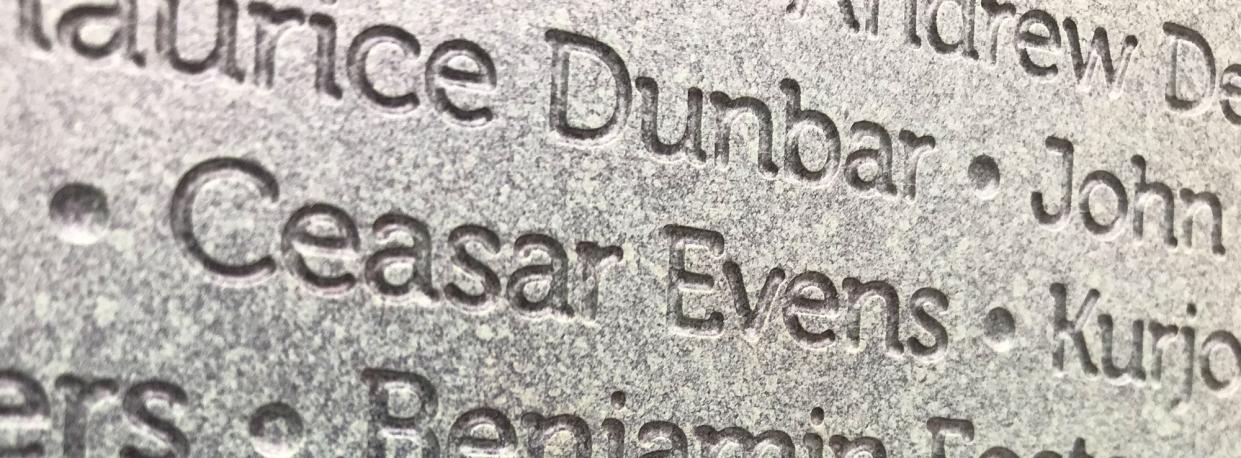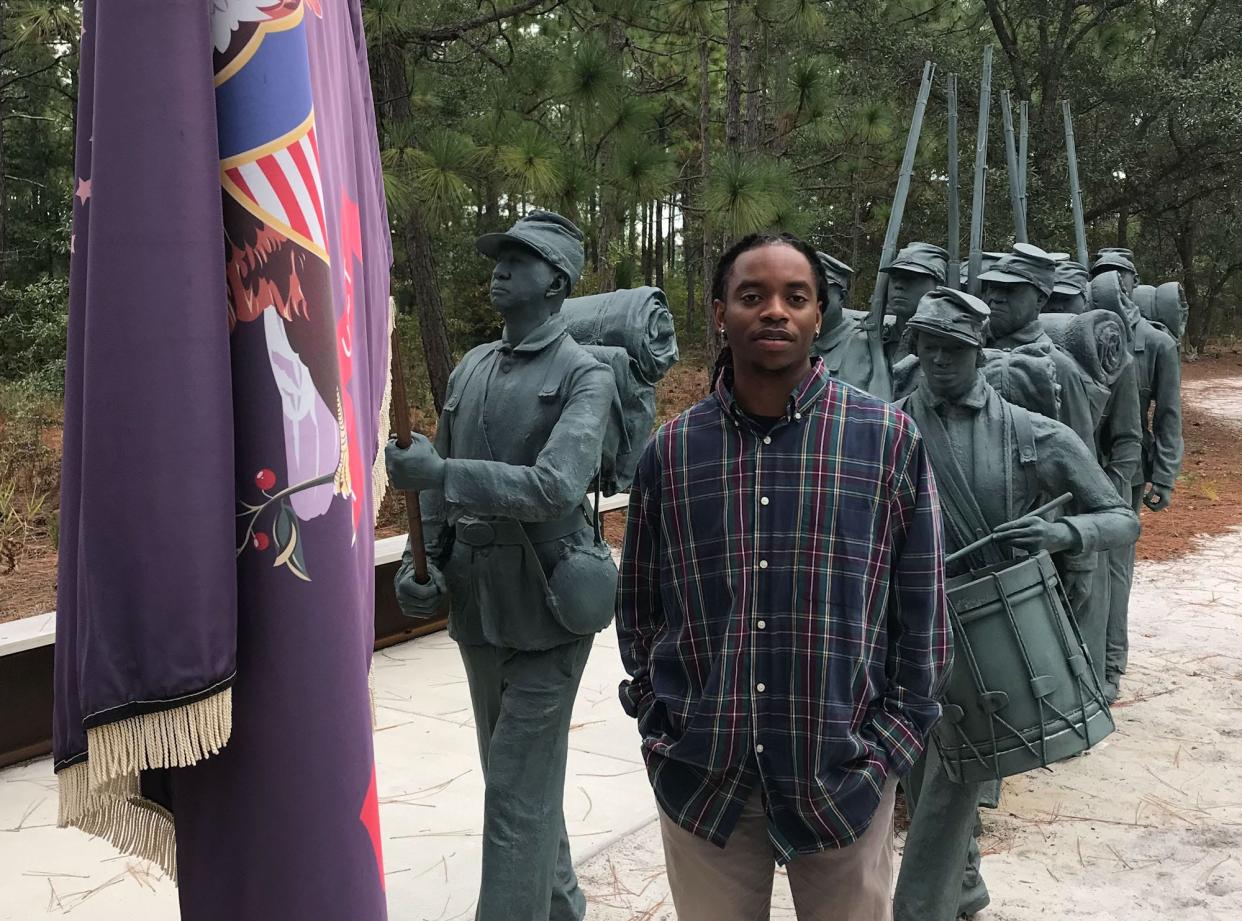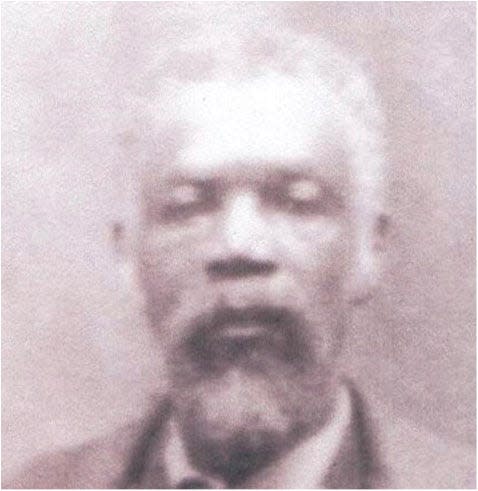How a Wilmington sculpture helped bring Black Civil War vet's extraordinary story to light

Marion Evans of Bolivia, in Brunswick County, was watching the television news one night in 2021 when she saw a story about "Boundless." The sculpture honoring soldiers who fought with the U.S. Colored Troops (USCT) during the Civil War was being installed at Wilmington's Cameron Art Museum.
Evans had been researching her family history, and specifically her great-great-grandfather, Ceasar Evens, who she knew had fought with the USCT and who she refers to as her grandfather, for about 20 years. So she went out to see the sculpture, which is engraved with the names of hundreds of USCT soldiers, "to see if my grandfather's name was actually included. I just wanted to see if he was there."
After attending a gallery talk at CAM by "Boundless" artist Stephen Hayes, Evans went out to see the sculpture on the CAM grounds with the museum's cultural curator, Daniel Jones.
"And I see her scanning left and right" looking for the name, Jones said. When she found it, Evans got emotional, "And we ended up talking out here for literally like two hours" as she told him the story of her family.

"It was quite emotional," Evans said. "I was very proud that he was included there on the very ground where he fought."
The CAM is located on the grounds of the Civil War Battle of Forks Road, which came after Union troops took Fort Fisher and were marching toward Wilmington, breaking the back of the Confederacy. Many USCT soldiers, like Evans' great-great-grandfather, participated in the battle, essentially fighting for their own freedom. Hayes used the likenesses of seven USCT descendants to create the soldiers depicted in "Boundless."
On Nov. 11, the CAM will celebrate the second anniversary of the "Boundless" installation with an event it's calling USCT Descendants Homecoming Day. USCT descendants from around the country are coming to Wilmington for the celebration, which will include Civil War re-enactments, lectures, live music, family activities and the premiere of a new documentary on the USCT descendants of which Evans and others are a part.
On Nov. 10, the museum will open a new exhibit, "Monument," inspired by the spirit of "Boundless." It will include work by multiple artists, including new work from "Boundless" sculptor Hayes.
As part of an ongoing project to connect stories from history with the present, Jones said, "We started looking for descendants" of USCT soldiers whose names are engraved on the statue. He got some help from Wilmington geneology expert Tim Pinnick.
"It sounds kind of corny to say it: Statues can't talk, but people can," Jones said, and that led to the idea of interviewing descendants for a documentary, which is being made by Wilmington filmmaker Adam Alphin. The story of Evans' family is just one to come to light since the sculpture has been installed, Jones said, but to him, it's one of the most moving.
"The stories were out there. We just didn't know them," Jones said. "The biggest story we found was right in our own backyard. That's special."

Marion Evans said her interest in her family's history began with her late grandmother, Goldie Evans, who died in 2018 a few days shy of her 102nd birthday.
"She loved to talk," Evans said, and would regale her with stories. Many of the stories were about Ceasar Evens, Goldie's grandfather, who died in 1928, when young Goldie was 11.
Goldie married Ceasar's grandson, so they weren't blood related, but "she lived in his house. And she thought so much of him, and remembered him. He was the big community man, the man who everybody went to for help," Evans said. "She told me he fought in the war, but at first I didn't know what war."
About 20 years ago, when doing family research via the internet became easier, Evans started looking for, and finding, the documentation behind her grandmother's stories.
"She would tell me things and I'd go on the internet and research it," Evans said. "It was a project of love between the two of us."
It was tricky at times, Evans said, because she found Ceasar Evens' first and last names spelled differently in different records. The spelling on "Boundless" is taken from the U.S. Army's enlistment rolls.
Eventually, Evans said, she was able to determine that her great-great grandfather was from Pitt County, where he was born into slavery. She believes that he and other family members were "hired out," or perhaps sold, to work on sites in the Brunswick County woods where turpentine was produced from pine trees. After the Civil War broke out Evens escaped from the turpentine camp where he was working, eventually making his way to New Bern, where he joined the Union Army.
Later, he wound up in Wilmington fighting in the Battle of Forks Road.
Records show he mustered out of the Army in 1867, Evans said, and returned to Brunswick County, where some of his family remained, living on the property of their former owner.
"His master had a son that was killed fighting in the Battle of Gettysburg," Evans said. "So we had sons fighting on different sides from the same plantation."
Evens helped his former owner run the family turpentine business, brought family members from Pitt County to Brunswick, employed many former slaves and eventually bought 228 acres of land from his former owner's family. That land, located near Bolivia off U.S. 17 in an area known as Piney Grove, is still in Evans' family, and the family graveyard and the Friendship Church her ancestors founded is still there.

"It's an honor and it's a blessing to have the land, and to know that he was able to do that for his family," Evans said.
Knowing the history, "It's very encouraging. It gives me strength. It lets me know I come from people who had a hard drive to live and to be successful. It makes me proud. Some people are embarrassed to know they came from slaves," she said, but knowing more about her family's history helps her make peace with that. "A lot of people don't know where they came from, so I feel so blessed."
Jones of the Cameron Museum said that Evans' story shows the power of Black community and resilience and has helped ground, localize and inform the "Boundless" sculpture, which has become a focal point for CAM and literally changed the space there. Regular performances of music and readings in the park adjacent to "Boundless" help keep the space fresh, contemporary and alive, and connect the past with the present.
"It shows what this is all about," he said.
As for Marion Evans, she said that when she visits the "Boundless" site, "I wonder, 'Did (her great-great grandfather) touch this tree? Did he sit in this shade?'"
Having Ceasar Evens' name out there in perpetuity "kind of feels like, finally, somebody else acknowledged his contribution and his role," Evans said. "I get excited and emotional about it, to see him honored in the way that he should be."
Want to go?
What: Opening of new exhibition "Monument" and USCT Descendants Homecoming Day
When: Nov. 10-11
Where: Cameron Art Musem, 3201 S. 17th St., Wilmington
Info: Admission to Descendants Homecoming Day Nov. 11 is free.
Details: CameronArtMuseum.org
SCHEDULE
Nov. 10: New exhibition "Monument" opens to the public
Nov. 11: Living history with USCT re-enactors, 10 a.m.-5 p.m.
Nov. 11: Reenactor Clark Morgan speaks at "Boundless," 11 a.m.
Nov. 11: Gospel performance by USCT descendant Andrena Evans, reception hall, noon
Nov. 11: Premiere of short film on the USCT descendants, 12:30 p.m.
Nov. 11: Lecture by Dr. Sherwin Bryant, Director of the Center for African American History at Northwestern University, 1:30 p.m.
Nov. 11: "Boundless" tour by Cultural Curator Daniel Jones at USCT Park, 3 p.m.
This article originally appeared on Wilmington StarNews: US Colored Troops sculpture in Wilmington honors Black Civil War vets
